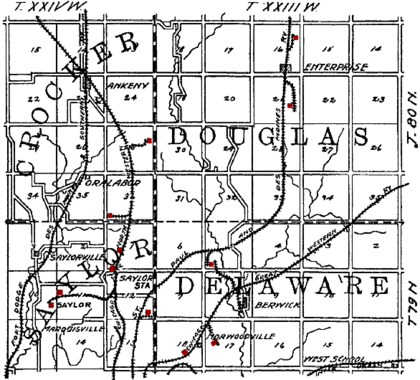Berwick, Iowa facts for kids
Quick facts for kids
Berwick, Iowa
|
|
|---|---|
| Country | |
| State | |
| County | Polk |
| Elevation | 850 ft (260 m) |
| Time zone | UTC-6 (Central (CST)) |
| • Summer (DST) | UTC-5 (CDT) |
| ZIP code |
50032
|
| Area code(s) | 515 |
| GNIS feature ID | 454534 |
Berwick is a small, quiet place in Polk County, Iowa, in the United States. It's called an unincorporated community, which means it's a town that doesn't have its own local government like a city does. Instead, it's looked after by the county. Berwick is located on the east side of Fourmile Creek and is part of the larger Des Moines area.
A Look Back at Berwick's History
Berwick has been a small community for a long time. In 1902, about 72 people lived there. By 1925, the population had grown slightly to 80 people. Later, in 1940, the population was 150.
Coal Mining in the Early 1900s
In the early 1900s, Berwick and a nearby place called Norwoodville were important for coal mining. There were several coal mines in the area.
One big mine was the Norwood-White shaft No. 1, also known as Klondike No. 1. A shaft is a deep tunnel that goes straight down into the ground to reach the coal. This mine was about 215 feet (65 meters) deep. It reached a coal seam that was about 4 feet (1.2 meters) thick. By 1908, this mine covered an area of about 200 acres (0.8 square kilometers) underground!
Another mine, Norwood-White shaft No. 2, was a bit newer and located half a mile to the east. In 1908, it covered about 40 acres (0.16 square kilometers). There was also the Delaware Coal Company mine, which was 170 feet (52 meters) deep. By 1908, this mine was smaller, covering less than 15 acres (0.06 square kilometers).
These mines were very productive. For example, in 1914, the Norwood-White mine produced over 100,000 tons of coal. This made it one of the top 24 coal producers in all of Iowa!
Mine Workers and Their Unions
Many people worked in these coal mines. To help protect their rights and ensure fair working conditions, many joined a group called the United Mine Workers. In 1912, the local branch of this union in Berwick had 220 members. Another local branch in Norwoodville, just a mile south, had 129 members. This shows how important coal mining was to the people living in Berwick and the surrounding communities.



